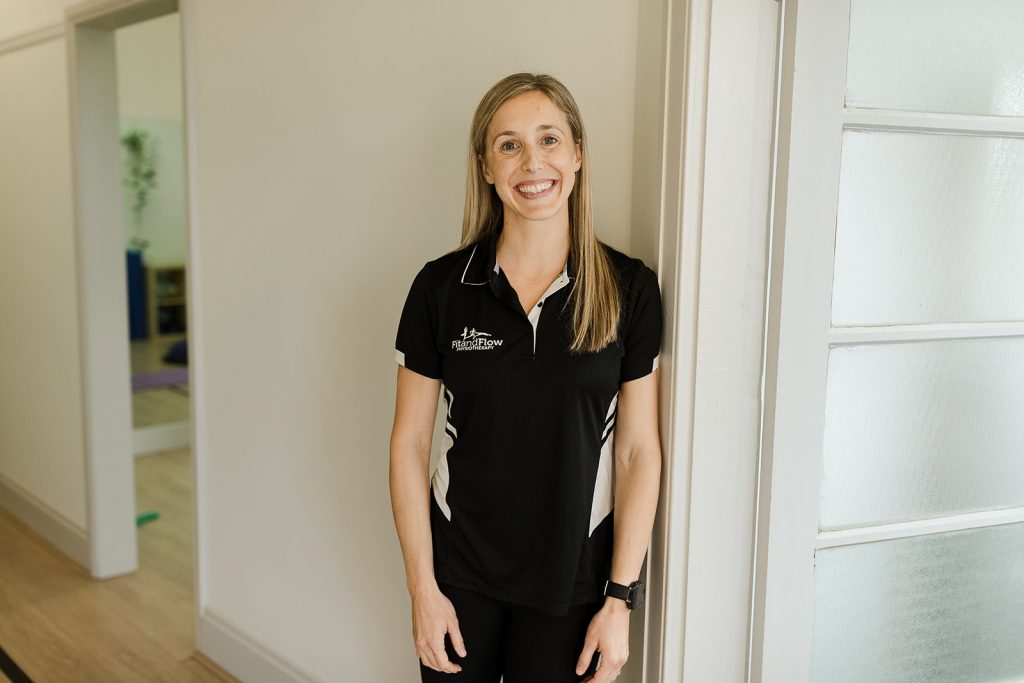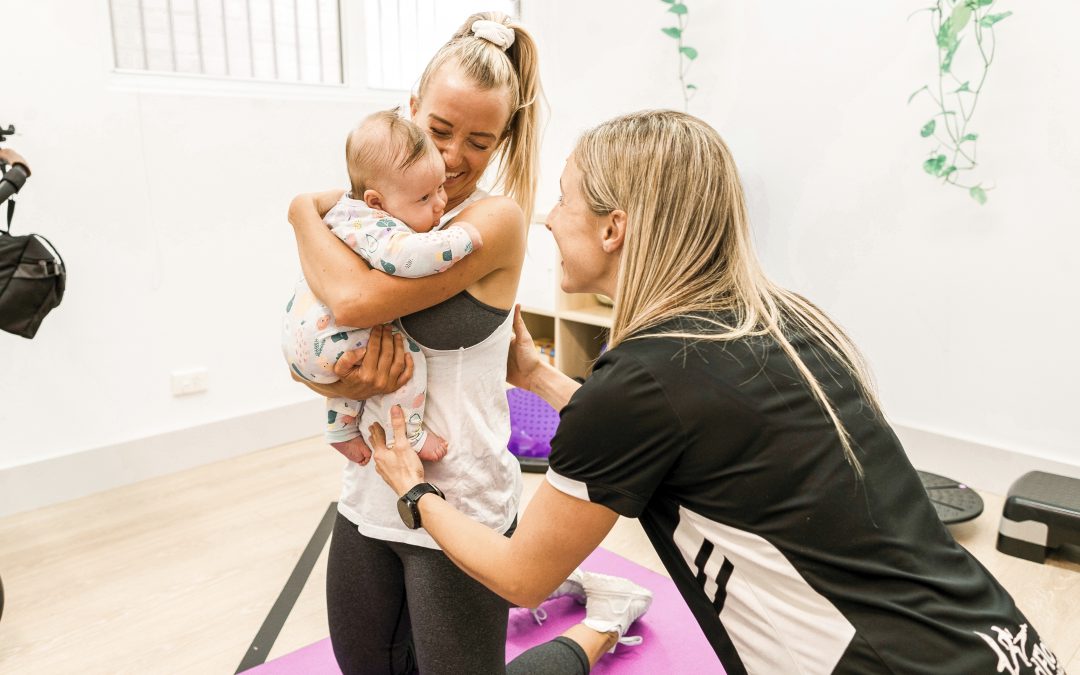As many of you know, I recently welcomed my beautiful baby boy into the world! If you follow me on my instagram @nourish_naturally, you would have seen that I have slowly and safely been getting back into training and exercise under the guidance of my Women’s Health Physio Ciaran Fox (nee Williams).
I’ve received hundreds of questions about postpartum exercise but this is not my area of expertise! So I’ve enlisted the help of my Women’s Health Physio Ciaran Fox to answer all your postpartum exercise questions!
What You Need To Know About Postpartum Exercise
When it comes to postpartum exercise guidelines there can’t be a “one-size-fits-all” approach. Every pregnancy is different, every labour and birth is different and as a result every woman’s post-partum journey and recovery need to be different!
Let’s take two women who were both healthy and active before they fell pregnant…
Jill suffered very little morning sickness and continued to run and lift weights into her third trimester, in the final few weeks she didn’t feel comfortable running anymore, but was able to continue walking and swimming.
Sara had terrible sickness for the first 18 weeks of her pregnancy, she felt terrible every day and only had enough energy to go to work and do short activities around the house. Sara also had placenta previa and her doctors didn’t want her doing any weights or running. She was cleared to start some walking and when her nausea subsided she started walking through her second and third trimester.

Both of these women want to return to high-impact exercise like running or sport after their pregnancy. Remember that Jill only had 4-weeks where she didn’t run or lift weights towards the end of her pregnancy, whereas Sara had around 9 months without running, high impact exercises or weights. These two women (without even looking at their labours, births and postpartum status) are going to have to approach their return to exercise in very different ways… Sara in particular will need to slowly build up her strength, fitness and impact tolerance because she has been away from activity for a longer period!
When we look at the labour and birth process, there is the obvious difference between a vaginal birth and a caesarean section. Women who deliver vaginally will often experience trauma to their perineum (the area between the anus and vulva), including the skin, muscles and connective tissues in this area. Whereas, women who deliver via caesarean section will experience trauma to their abdomen including the muscle layers, connective tissues and skin in this area. Other factors like the time spent in labour, how fast (or slow) the “pushing” phase of labour was, how large the baby being delivered was, if the assistance of forceps or vacuum were needed and the extent of any tearing in the perineum can all affect the recovery needed from the labour and birth.

Exercise In The Early Postpartum Period (<6 Weeks)
“Listen to your body”, there has never been a truer phrase when it comes to the early postpartum period.
In that early postpartum period, your body is trying to recover from the end of your pregnancy (when you were carrying around extra weight and often experiencing sleepless nights) and your efforts in labour.
You are often in pain (from your c-section site and/or your perineum), you are also learning how to look after a new baby, functioning on reduced sleep and possibly even attempting to breastfeed.
During this early phase, it is important to give your body adequate rest and time to recover!
Women who deliver via c-section are given the same instructions as any abdominal surgery:
- Avoid lifting, driving and any abdominal loading exercises for 6-weeks in order to allow the abdomen to heal and avoid overloading the stitches.
I would give women who have delivered vaginally similar advice:
- Reduce the loads through your pelvic floor in those first 6-weeks in order to allow healing in the perineum and avoid overloading the tissues!
Keep in mind that your pelvic floor is under load or working for you whenever you are up against gravity! So it’s being loaded whenever you are sitting and standing throughout the day and more so with walking or carrying bub!

Answering Your Questions About Postpartum Exercise
Many of your questions have asked about what exercises to avoid or start in the early postpartum period.
It is important that before you commence any strength or cardio exercise that you seek an assessment and advice from a physiotherapist experienced treating women in the post-partum period.
Your physiotherapist assessment should include the following:
- Assess your body as a whole, looking at key areas like pelvic, hip and trunk strength and control depending on what activities you are looking to return to.
- Assess your pelvic floor, which will generally involve an internal examination to determine pelvic floor muscle activation and strength and connective tissue integrity in the perineum.
- Assess your abdominal strength and any abdominal separation.
By assessing all of these areas and taking into account your activity levels before and during your pregnancy, your physiotherapist should then start you on an individualised exercise program to address any activation, coordination and strength deficits. They will also give you advice on what level of activity you could begin returning to and how it will be progressed over subsequent weeks to help you to return to what you love!
Most physiotherapists will assess you somewhere between 4-8 weeks post-partum. This should allow your body to start some of it’s natural recovery and healing and will ensure that you’re not too sore for an assessment.

In the early postpartum period (before your assessment with a physiotherapist) many women find that they need to return to some light activity, more for their mental well-being than fitness or strength! I encourage women that if they feel up to a light walk or (once you have been cleared by your doctor that your stitches have healed) a light swim may make you feel more human during those first few weeks!
It is important that you monitor your own body for symptoms that the exercise you have started might be too hard, these include:
- Any pain in your body in response to the exercise e.g. hip pain, lower back or pelvic pain, foot pain, pelvic floor pain
- Any feelings of heaviness or bulging in your perineum
- Any incontinence (leakage) of urine, faeces or flatulence
* Keep in mind that most prams weigh upwards of 10kg (and this isn’t including the weight of your newborn and a baby bag!), so in the first few weeks pushing the pram when walking may be too taxing for you! Also be wary of doing long walks with your baby in a carrier because this is akin to doing a walk with a weight vest on and may also be too much in the early postpartum period!
* Even if you delivered vaginally you may not be ready to start any abdominal exercises in the first 6-weeks. Even some simple abdominal exercises like a crunch or sit-up put a lot of downward pressure on your pelvic floor and this can overload your perineum in the early postpartum period! Make sure you check with your physiotherapist before returning to abdominal exercises!
Pelvic Floor
You have all asked questions about pelvic floor exercises after birth, which is GREAT! The fact that more women are aware of their pelvic floor and the need to rehabilitate it after pregnancy and birthing babies, means that less women should be suffering in silence and we might even be able to prevent women having issues like incontinence (leakage) and prolapse in the future!
Remember that in the early postpartum period, your pelvic floor may be swollen and tender (if you gave birth vaginally). This means that any exercises you do in this early postpartum period should aim to reduce swelling and get the muscles to switch on again (rather than gaining strength)! Look to start with small pulses of your pelvic floor muscles i.e. “squeeze and relax” and only small numbers of activations before having a rest.
Reducing Pain
The following can help to reduce pain and swelling in your perineum:
- R – REST: try to give yourself periods of time in the day where you lay down to give your pelvic floor a rest from working up against gravity
- I – ICE: many postnatal wards will have small ice-blocks in the freezer to be used for icing your perineum. Remember not to put the ice directly onto your skin, but rather wrap it in paper towel or create a hole in your panty-liner to put the ice-block in.
- C – COMPRESSION: you may choose to wear recovery garments, like recovery shorts, that give your perineum some support and compression to reduce swelling
- E – ELEVATION: again try to have lying breaks so your pelvis is elevated to allow swelling to move away from the area.

Pelvic Floor Exercises
Whilst many women are keen to start their pelvic floor exercises as early as possible in the postpartum period, it is also important that you are doing them correctly!
Studies that looked at whether women can perform an effective pelvic floor muscle contraction with only verbal instructions found that 30% of women didn’t activate their pelvic floor muscles at all but were instead using their leg muscles to “squeeze”. Some women (25%) were even pushing down and out with their pelvic floor muscles rather than squeezing in and lifting up!
In your postpartum physiotherapy assessment, your pelvic floor will be assessed to ensure that you are activating your pelvic floor muscles correctly. Often your physiotherapist will need to try different “cues” til they find the one that helps you to achieve the best activation or “squeeze” of your pelvic floor.
Once you can achieve this correct activation of your pelvic floor, your physiotherapist can then work out your individualised program of pelvic floor exercises. Depending on what your pelvic floor needs e.g. more strength in the squeeze or more holding time, will then effect the type of exercises you are given! Your physiotherapist will also tell you exactly how many repetitions you should aim for in each session, in my experience a lot of women are told to do 10x 10second holds, but most struggle to do 5x 2second holds in the early postpartum period.
PART 2 on Prolapse and Abdominal Separation (Rectus Abdominus Diastasis) COMING SOON!
About Ciaran

Ciaran Fox (nee Williams) is a physiotherapist based in Caringbah, Sydney. Ciaran has a strong background in musculoskeletal, sports and women’s health physiotherapy.
Having started her career working on the sidelines of women’s sports fields and within private practice locations, she developed an interest in helping women with both musculoskeletal and pelvic floor issues! She has completed postgraduate courses in pregnancy physiotherapy, hip, pelvis and rib pain and women’s health management of incontinence, prolapse and return to sport screening!
She is passionate about working with women through their pregnancies and into the postpartum period, to help them remain active or return to the activities that they love!
Outside of the clinic, Ciaran has her hands full with 8-month old Owen. She is also a keen runner and loves a good sandhills session or more recently a run with Owen in the running pram!
Contact Details and to book an appointment with Ciaran:
Ph: (02) 8544 3680
6/345 Kingsway Caringbah, NSW 2229
Editor's Note: This post is for information purposes only. Always consult your health care professional for personalised advice.

